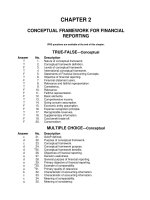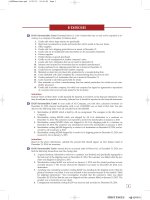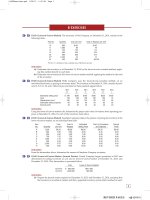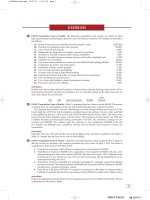Exercise intermediate accounting 15th kiesoch05
Bạn đang xem bản rút gọn của tài liệu. Xem và tải ngay bản đầy đủ của tài liệu tại đây (309.62 KB, 8 trang )
c05BExercises.qxd
11/20/12
11:36 AM
Page 1
B EXERCISES
2
3
E5-1B (Balance Sheet Classifications) Presented below are a number of balance sheet accounts of
Castillo Inc.
(a)
(b)
(c)
(d)
(e)
(f)
(g)
Trading Securities.
Work in Process.
Investment in Preferred Stock.
Unearned Subscription Revenue.
Accrued Vacation Pay.
Treasury Stock.
Income Taxes Payable.
(h)
(i)
(j)
(k)
(l)
(m)
(n)
Warehouse in Process of Construction.
Deficit.
Cash Dividends Payable.
Petty Cash.
Accrued Interest on Notes Payable.
Accumulated Depreciation.
Common Stock Distributable.
Instructions
For each of the accounts above, indicate the proper balance sheet classification. In the case of borderline
items, indicate the additional information that would be required to determine the proper classification.
2
3
E5-2B (Classification of Balance Sheet Accounts) Presented below are the captions of Chan Company’s
balance sheet.
(a)
(b)
(c)
(d)
(e)
Current assets.
Investments.
Property, plant, and equipment.
Intangible assets.
Other assets.
(f)
(g)
(h)
(i)
(j)
Current liabilities.
Non-current liabilities.
Capital stock.
Additional paid-in capital.
Retained earnings.
Instructions
Indicate by letter where each of the following items would be classified.
1.
2.
3.
4.
5.
6.
7.
8.
9.
10.
2
3
Cash surrender value of life insurance.
Prepaid insurance.
Taxes payable.
Bonds payable.
Notes payable (due next year).
Bond sinking fund.
Common stock.
Merchandise inventory.
Office supplies.
Land.
11.
12.
13.
14.
15.
16.
17.
18.
19.
20.
Trading securities.
Preferred stock.
Allowance for doubtful accounts.
Accounts receivable.
Goodwill.
Current portion of long-term debt.
Wages payable.
Buildings.
Premium on bonds payable.
Trade accounts payable.
E5-3B (Classification of Balance Sheet Accounts) Assume that Clark Enterprises uses the following
headings on its balance sheet.
(a)
(b)
(c)
(d)
(e)
Current assets.
Investments.
Property, plant, and equipment.
Intangible assets.
Other assets.
(f)
(g)
(h)
(i)
(j)
Current liabilities.
Long-term liabilities.
Capital stock.
Paid-in capital in excess of par.
Retained earnings.
Instructions
Indicate by letter how each of the following usually should be classified. If an item should appear in a
note to the financial statements, use the letter “N” to indicate this fact. If an item need not be reported at
all on the balance sheet, use the letter “X.”
1.
2.
3.
4.
5.
6.
7.
8.
Twenty-year issue of bonds payable that will
mature within the next year. (No sinking fund
exists, and refunding is not planned.)
Machinery retired from use and held for sale.
Discount on bonds payable. (Assume related
to bonds payable in No. 1, above.)
Accumulated depreciation.
Salaries that company budget shows will be
paid to employees within the next year.
Accrued interest on bonds payable.
Fully depreciated machine still in use.
Accrued interest on notes receivable.
9. Premium on preferred stock.
10. Copyrights.
11. Unearned subscriptions revenue.
12. Stock owned in affiliated companies.
13. Advances to suppliers.
14. Treasury stock.
15. Unearned rent revenue.
16. Sales tax payable.
17. Petty cash fund.
18. Unexpired insurance.
19. Noncontrolling interest.
1
c05BExercises.qxd
2
2
•
11/20/12
11:36 AM
Page 2
Chapter 5 Balance Sheet and Statement of Cash Flows
3
E5-4B (Preparation of a Classified Balance Sheet) Assume that Cluver Inc. has the following accounts
at the end of the current year.
Accrued Salaries Payable.
Cash Restricted for Plant Expansion.
Land Held for Future Plant Site.
Accumulated Depreciation—Buildings.
Retained Earnings
Unearned Subscriptions Revenue.
Finished Goods.
Accounts Receivable.
Bonds Payable (due in 4 years).
Receivables—Officers (due in one year).
Premium on Common Stock.
Allowance for Doubtful Accounts—
Accounts Receivable
13. Noncontrolling interest
1.
2.
3.
4.
5.
6.
7.
8.
9.
10.
11.
12.
14.
15.
16.
17.
18.
19.
20.
21.
22.
23.
24.
25.
Common Stock
Treasury Stock (at cost).
Raw Materials.
Unearned Rent Revenue.
Copyrights.
Notes Receivable (short-term).
Cash.
Buildings.
Work in Process.
Preferred Stock Investments—Long-term.
Note Payable, short-term
Discount on Bonds Payable.
Instructions
Prepare a classified balance sheet in good form. (No monetary amounts are necessary.)
3
E5-5B (Preparation of a Corrected Balance Sheet) Darling Company has decided to expand its operations. The bookkeeper recently completed the balance sheet in order to obtain additional funds for
expansion.
DARLING COMPANY
BALANCE SHEET
DECEMBER 31, 2014
Current assets
Cash
Accounts receivable (net)
Inventories at lower of average cost or market
Available-for-sale securities—at cost
(fair value $65,000)
Property, plant, and equipment
Building (net)
Office equipment (net)
Land held for future use
Intangible assets
Patents
Cash surrender value of life insurance
Prepaid expenses
Current liabilities
Accounts payable
Notes payable (due next month)
Pension obligation
Unearned revenue
Premium on bonds payable
Long-term liabilities
Bonds payable
Stockholders’ equity
Common stock, $1.00 par, authorized
1,000,000 shares, issued 610,000
Additional paid-in capital
Retained earnings
$ 105,000
411,000
561,000
50,000
1,561,000
125,000
251,000
128,000
26,000
39,000
367,000
75,000
361,000
26,000
36,000
1,500,000
610,000
200,000
?
Instructions
Prepare a revised balance sheet given the available information. Assume that the accumulated depreciation balance for the buildings is $302,000 and for the office equipment, $86,000. The allowance for doubtful accounts has a balance of $37,000. The pension obligation is considered a long-term liability.
3
E5-6B (Corrections of a Balance Sheet) The bookkeeper for Odie Company has prepared the following
balance sheet as of June 30, 2014.
c05BExercises.qxd
11/20/12
11:36 AM
Page 3
B Exercises
ODIE COMPANY
BALANCE SHEET
AS OF JUNE 30, 2014
Cash
Accounts receivable (net)
Inventories
Equipment (net)
Goodwill
$ 26,500
81,000
93,000
187,000
50,000
Notes and accounts payable
Long-term liabilities
Stockholders’ equity
$ 126,000
50,000
261,500
$437,500
$437,500
The following additional information is provided.
1.
2.
3.
4.
5.
Cash includes $800 in a petty cash fund and $14,000 in a bond sinking fund.
The net accounts receivable balance is comprised of the following three items: (a) accounts
receivable—debit balances $96,000; (b) accounts receivable—credit balances $8,000; (c) allowance
for doubtful accounts $7,000.
Merchandise inventory costing $11,200 was shipped out on consignment on June 30, 2014. The ending inventory balance does not include the consigned goods. Receivables in the amount of $11,200
were recognized on these consigned goods.
Equipment had a cost of $260,000 and an accumulated depreciation balance of $73,000.
Taxes payable of $21,500 were accrued on June 30. Odie Company, however, had set up a cash fund
to meet this obligation. This cash fund was not included in the cash balance, but was offset against
the taxes payable amount.
Instructions
Prepare a corrected classified balance sheet as of June 30, 2014, from the available information, adjusting
the account balances using the additional information.
3
E5-7B (Current Assets Section of the Balance Sheet) Presented below are selected accounts of Coffey
Company at December 31, 2014.
Finished Goods
Revenue Received in Advance
Bank Overdraft
Equipment
Work-in-Process
Cash
Short-term Investments in Stock
Customer Advances
Cash Restricted for Plant Expansion
$ 78,000
135,000
12,000
379,500
51,000
55,500
46,500
54,000
75,000
Cost of Goods Sold
Notes Receivable
Accounts Receivable
Raw Materials
Supplies Expense
Allowance for Doubtful Accounts
Licenses
Additional Paid-in Capital
Treasury Stock
$3,150,000
60,000
241,500
310,500
90,000
18,000
27,000
132,000
33,000
The following additional information is available.
1.
2.
3.
4.
5.
6.
7.
Inventories are valued at lower-of-cost-or-market using LIFO.
Equipment is recorded at cost. Accumulated depreciation, computed on a straight-line basis, is $75,900.
The short-term investments have a fair value of $43,500. (Assume they are trading securities.)
The notes receivable are due April 30, 2016, with interest receivable every April 30. The notes bear
interest at 12%. (Hint: Accrue interest due on December 31, 2014.)
The allowance for doubtful accounts applies to the accounts receivable. Accounts receivable of
$75,000 are pledged as collateral on a bank loan.
Licenses are recorded net of accumulated amortization of $21,000.
Treasury stock is recorded at cost.
Instructions
Prepare the current assets section of Coffey Company’s December 31, 2014, balance sheet, with appropriate disclosures.
2
E5-8B (Current vs. Long-term Liabilities) Constantin Corporation is preparing its December 31, 2014,
balance sheet. The following items may be reported as either a current or long-term liability.
1.
2.
At December 31, bonds payable of $200,000,000 are outstanding. The bonds pay 12% interest every September 30 and mature in installments of $50,000,000 every September 30, beginning September 30, 2015.
On December 15, 2014, Constantin declared a cash dividend of $5.00 per share to stockholders of
record on December 31. The dividend is payable on January 15, 2015. Constantin has issued
1,000,000 shares of common stock, of which 50,000 shares are held in treasury.
•
3
c05BExercises.qxd
4
•
11/20/12
11:36 AM
Page 4
Chapter 5 Balance Sheet and Statement of Cash Flows
3.
4.
Also on December 31, Constantin declared a 10% stock dividend to stockholders of record on January 15, 2015. The dividend will be distributed on January 31, 2015. Constantin’s common stock
has a par value of $20 per share and a market value of $76 per share.
At December 31, 2013, customer advances were $24,000,000. During 2014, Constantin collected
$60,000,000 of customer advances, and advances of $50,000,000 were earned.
Instructions
For each item above indicate the dollar amounts to be reported as a current liability and as a long-term
liability, if any.
2
3
E5-9B (Current Assets and Current Liabilities) The current assets and liabilities sections of the balance
sheet of Cooper Company appear as follows.
COOPER COMPANY
BALANCE SHEET (PARTIAL)
DECEMBER 31, 2014
Cash
Accounts receivable
Less: Allowance for
doubtful accounts
Inventories
Prepaid expenses
$100,000
$222,500
Accounts payable
Notes payable
$152,500
167,500
$320,000
17,500
205,000
427,500
22,500
$755,000
The following errors in the corporation’s accounting have been discovered:
1. The inventory included $67,500 of merchandise that had been received at December 31 but for
which no purchase invoices had been received or entered. Of this amount, $30,000 had been received on consignment; the remainder was purchased f.o.b. destination, terms 2/10, n/30.
2. January 2015 cash disbursements entered as of December 2014 included payments of accounts
payable in the amount of $97,500, on which a cash discount of 2% was taken.
3. Cash, not including cash sales, collected in January 2015 and entered as of December 31, 2014, totaled $88,310. Of this amount, $58,310 was received on account after cash discounts of 2% had been
deducted; the remainder represented the proceeds of a bank loan.
4. Sales for the first four days in January 2015 in the amount of $75,000 were entered in the sales book
as of December 31, 2014. Of these, $53,750 were sales on account, and the remainder were cash
sales.
Instructions
(a) Restate the current assets and liabilities sections of the balance sheet in accordance with good accounting practice. (Assume that both accounts receivable and accounts payable are recorded
gross.)
(b) State the net effect of your adjustments on Cooper Company’s retained earnings balance.
2
3
E5-10B (Current Liabilities) Travis is the controller of Dave Corporation and is responsible for the preparation of the year-end financial statements. The following transactions occurred during the year.
(a) Credit sales for the year amounted to $5,000,000. Dave’s expense provision for doubtful accounts
is estimated to be 3% of credit sales.
(b) On December 15, 2014, the company declared a $1.00 per share dividend on the 40,000 shares of
common stock outstanding, to be paid on January 5, 2015.
(c) During the year, customer advances of $80,000 were received; $25,000 of this amount was earned
by December 31, 2014.
(d) On December 1, 2014, the company borrowed $300,000 at 8% per year. Interest is paid quarterly.
(e) On December 20, 2014, an employee filed a legal action against Dave Corporation for $50,000 for
wrongful dismissal. Management believes the action to be frivolous and without merit. The likelihood of payment to the employee is remote.
(f) Bonuses to key employees based on net income for 2014 are estimated to be $75,000.
Instructions
For each item above, indicate the dollar amount to be reported as a current liability. If a liability is not reported, explain why.
c05BExercises.qxd
11/20/12
11:36 AM
Page 5
B Exercises
3
E5-11B (Balance Sheet Preparation) Presented below is the adjusted trial balance of De Young Corporation at December 31, 2014.
Debits
Cash
Office Supplies
Prepaid Insurance
Equipment
Accumulated Depreciation—Equipment
Trademarks
Accounts Payable
Salaries and Wages Payable
Unearned Service Revenue
Bonds Payable, due 2019
Common Stock
Retained Earnings
Service Revenue
Salaries and Wages Expense
Insurance Expense
Rent Expense
Interest Expense
Credits
$
?
2,640
2,200
105,600
$ 8,800
2,090
22,000
1,100
4,400
19,800
22,000
55,000
22,000
19,800
3,080
2,640
1,980
Total
$
?
$ ?
Additional information:
1.
2.
Net loss for the year was $5,500.
No dividends were declared during 2014.
Instructions
Prepare a classified balance sheet as of December 31, 2014.
3
E5-12B (Preparation of a Balance Sheet) Presented below is the trial balance of Do Corporation at
December 31, 2014.
Debits
Cash
Sales
Trading Securities (at cost, $145,000)
Cost of Goods Sold
Long-term Investments in Bonds
Long-term Investments in Stocks
Short-term Notes Payable
Accounts Payable
Selling Expenses
Investment Revenue
Land
Buildings
Dividends Payable
Accrued Liabilities
Accounts Receivable
Accumulated Depreciation—Buildings
Allowance for Doubtful Accounts
Administrative Expenses
Interest Expense
Inventories
Extraordinary Gain
Prior Period Adjustment—Depr. Error
Long-term Notes Payable
Equipment
Bonds Payable
Accumulated Depreciation—Equipment
Franchise (net of $80,000 amortization)
Common Stock ($5 par)
Treasury Stock
Patent (net of $30,000 amortization)
Retained Earnings
Additional Paid-in Capital
Totals
$
Credits
98,500
$4,050,000
76,500
2,400,000
149,500
138,500
45,000
227,500
1,000,000
31,500
130,000
520,000
68,000
48,000
217,500
76,000
12,500
450,000
105,500
298,500
40,000
70,000
450,000
300,000
500,000
30,000
80,000
500,000
95,500
97,500
109,000
40,000
$6,227,500
$6,227,500
•
5
c05BExercises.qxd
6
•
11/20/12
11:36 AM
Page 6
Chapter 5 Balance Sheet and Statement of Cash Flows
Instructions
Prepare a balance sheet at December 31, 2014, for Do Corporation. Ignore income taxes.
5
E5-13B (Statement of Cash Flows—Classifications) The major classifications of activities reported in
the statement of cash flows are operating, investing, and financing. Classify each of the transactions listed
below as:
1.
2.
3.
4.
5.
Operating activity—add to net income.
Operating activity—deduct from net income.
Investing activity.
Financing activity.
Not reported as a cash flow.
The transactions are as follows.
(a)
(b)
(c)
(d)
(e)
(f)
(g)
6
Depreciation of machinery.
Payment of cash dividends.
Purchase of treasury stock.
Decrease in accounts payable during the year.
Increase in accounts receivable during the year.
Loss on sale of equipment.
Exchange of furniture for office equipment.
(h)
(i)
(j)
(k)
(l)
(m)
Sale of equipment.
Purchase of land and building.
Amortization of patent.
Issuance of bonds for plant assets.
Redemption of bonds.
Issuance of capital stock.
E5-14B (Preparation of a Statement of Cash Flows) The comparative balance sheets of Duong Inc. at the
beginning and the end of the year 2014 appear below.
DUONG INC.
BALANCE SHEETS
Assets
Cash
Accounts receivable
Equipment
Less: Accumulated depreciation
Total
Dec. 31, 2014
Jan. 1, 2014
$ 90,000
182,000
78,000
(34,000)
$ 26,000
176,000
44,000
(22,000)
$316,000
$224,000
$ 40,000
200,000
76,000
$ 30,000
160,000
34,000
$316,000
$224,000
Inc./Dec.
$64,000
6,000
34,000
12,000
Inc.
Inc.
Inc.
Inc.
Liabilities and Stockholders’ Equity
Accounts payable
Common stock
Retained earnings
Total
$10,000 Inc.
40,000 Inc.
42,000 Inc.
Net income of $88,000 was reported, and dividends of $46,000 were paid in 2014. New equipment was
purchased and none was sold.
Instructions
Prepare a statement of cash flows for the year 2014.
6
7
E5-15B (Preparation of a Statement of Cash Flows) Presented below is a condensed version of the comparative balance sheets for Garcia Corporation for the last two years at December 31.
Cash
Accounts receivable
Investments
Equipment
Less: Accumulated depreciation
Current liabilities
Capital stock
Retained earnings
2014
2013
$442,500
450,000
130,000
745,000
(265,000)
335,000
400,000
767,500
$195,000
462,500
185,000
600,000
(222,500)
377,500
400,000
442,500
Additional information:
Investments were sold at a loss (not extraordinary) of $25,000; no equipment was sold; cash dividends
paid were $75,000; and net income was $400,000.
c05BExercises.qxd
11/20/12
11:36 AM
Page 7
B Exercises
Instructions
(a) Prepare a statement of cash flows for 2012 for Garcia Corporation.
(b) Determine Garcia Corporation’s free cash flow.
6
7
E5-16B (Preparation of a Statement of Cash Flows) A comparative balance sheet for Gokhale Corporation is presented below.
December 31
Assets
Cash
Accounts receivable
Inventories
Land
Equipment
Accumulated depreciation—equipment
Total
2014
2013
$109,500
123,000
270,000
106,500
390,000
(103,500)
$ 33,000
99,000
283,500
165,000
300,000
(63,000)
$895,500
$817,500
$ 51,000
225,000
321,000
298,500
$ 70,500
300,000
246,000
201,000
$895,500
$817,500
Liabilities and Stockholders’ Equity
Accounts payable
Bonds payable
Common stock ($1 par)
Retained earnings
Total
Additional information:
1.
2.
3.
Net income for 2014 was $187,500.
Cash dividends of $90,000 were declared and paid.
Bonds payable amounting to $75,000 were retired through issuance of common stock.
Instructions
(a) Prepare a statement of cash flows for 2014 for Gokhale Corporation.
(b) Determine Gokhale Corporation’s current cash debt coverage ratio, cash debt coverage ratio, and
free cash flow. Comment on its liquidity and financial flexibility.
3
6
E5-17B (Preparation of a Statement of Cash Flows and a Balance Sheet) Gonzalvo Corporation’s balance sheet at the end of 2013 included the following items.
Current assets
Land
Building
Equipment
Accum. depr.—building
Accum. depr.—equipment
Patents
Total
$282,000
36,000
144,000
108,000
(36,000)
(13,200)
48,000
Current liabilities
Bonds payable
Common stock
Retained earnings
Total
$180,000
120,000
216,000
52,800
$568,800
$568,800
The following information is available for 2014.
1.
2.
3.
4.
5.
6.
7.
8.
9.
10.
Treasury stock was purchased at a cost of $13,200.
Cash dividends of $36,000 were declared and paid.
A long-term investment in stock was purchased for $19,200.
Current assets other than cash increased by $34,800. Current liabilities increased by $15,600.
Depreciation expense was $4,800 on the building and $10,800 on equipment.
Net income was $66,000.
Bonds payable of $60,000 were issued.
An addition to the building was completed at a cost of $32,400.
Patent amortization was $3,000.
Equipment (cost $24,000 and accumulated depreciation $9,600) was sold for $12,000.
Instructions
(a) Prepare a statement of cash flows for 2014.
(b) Prepare a balance sheet at December 31, 2014.
•
7
c05BExercises.qxd
8
6
•
11/20/12
11:36 AM
Page 8
Chapter 5 Balance Sheet and Statement of Cash Flows
7
E5-18B (Preparation of a Statement of Cash Flows Analysis) A comparative balance sheet for Harrison
Corporation is presented below.
HARRISON CORPORATION
BALANCE SHEETS
December 31
Assets
Cash
Accounts receivable
Inventory
Building
Accumulated depreciation—building
Land
Total
2014
2013
$ 36,500
41,000
90,000
130,000
(34,500)
35,500
$ 11,000
33,000
94,500
100,000
(21,000)
55,000
$ 298,500
$ 272,500
$ 17,000
75,000
107,000
99,500
$ 23,500
100,000
82,000
67,000
$ 298,500
$272,500
Inc/Dec.
$ 25,500
8,000
4,500
30,000
13,500
19,500
Inc.
Inc.
Dec.
Inc.
Inc.
Dec.
6,500
25,000
25,000
32,500
Dec.
Dec.
Inc.
Inc.
Liabilities and Stockholders’ Equity
Accounts payable
Bonds payable
Common stock ($1 par)
Retained earnings
Total
Additional information:
Cash dividends of $30,000 were declared and paid.
Bonds payable of $25,000 were converted to common stock.
Instructions
(a) Prepare a statement of cash flows for 2014.
(b) Compute the current ratio (current assets Ϭ current liabilities) as of December 31, 2013 and 2014
and compute free cash flow for the year 2014.
(c) In light of the analysis in (b), comment on Harrison’s liquidity and financial flexibility.









